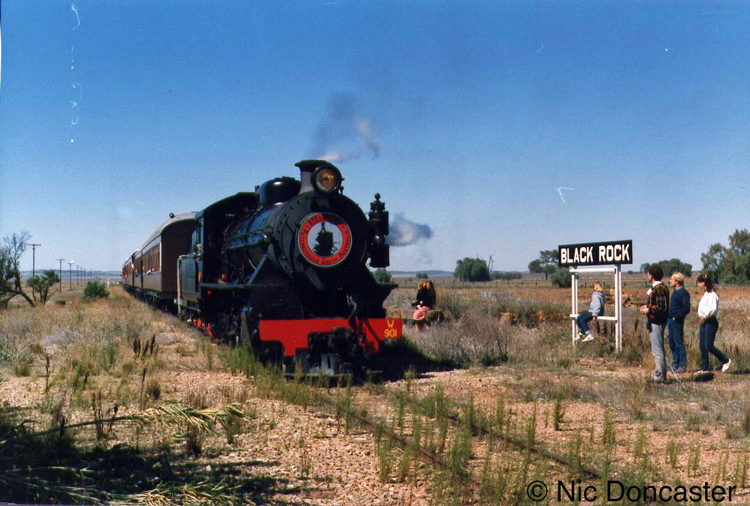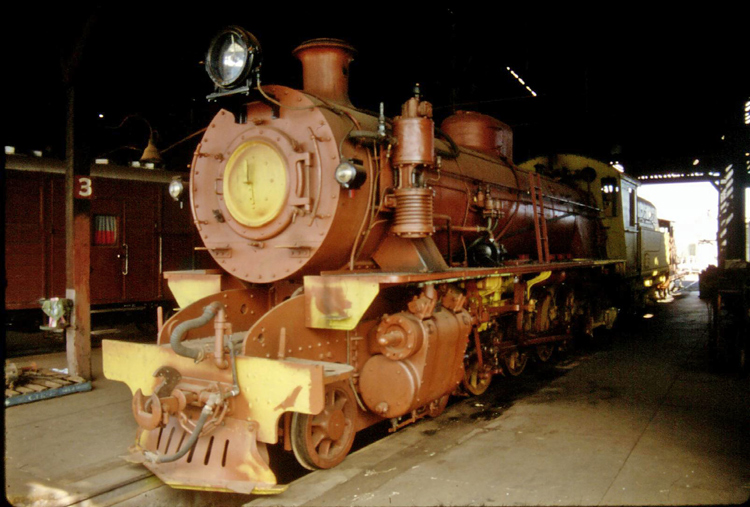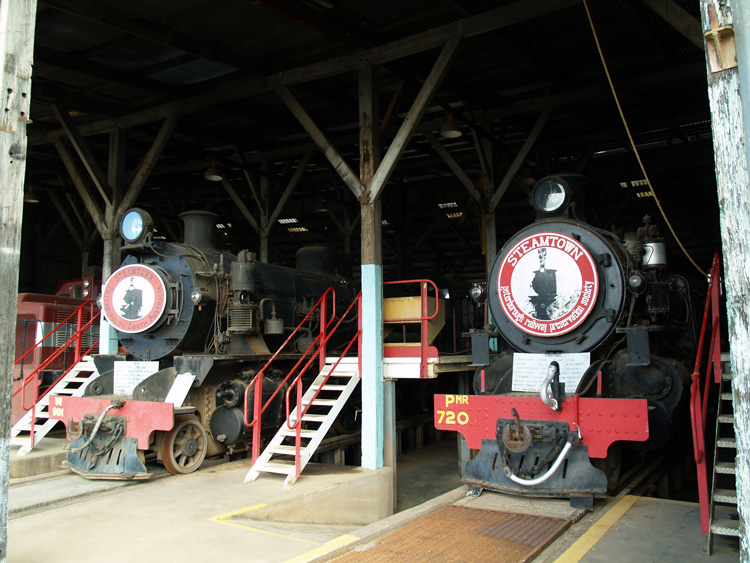
|
W 901 Steamtown Heritage Rail Centre, Peterborough |

This photo is kindly provided by Nic Doncaster and shows W 901 on a Steamtown run through Black Rock in 1993.
|
W 901 was built by Beyer Peacock & Co, Manchester (builder's number 7378 of 1951) and entered service in April 1951 as the class leader of sixty "W-class" 4-8-2 locomotives delivered to the Western Australian Government Railways for light lines service. The W-class proved to be highly successful locomotives, displacing older O-class 2-8-0T+T and G-class 2-6-0 & 4-6-0 types on secondary lines and augmenting the V and S-classes on main line duties. An interesting feature of this locomotive design was the sloping cab front which was parallel with the boiler / firebox back plate; this minimised the area of boiler that was within the cab. Anyone who has been in the cab of a steam locomotive during the heat of the Australian summer would appreciate this feature! The Silverton Tramway in NSW also purchased 4 locomotives of near identical design, of which W 22, W 24 and W 25 are also preserved. These locomotives were built to the West Australian Government Railway's W-class 4-8-2 design but with minor differences, the most visible being the decorative cowling along the boiler top which originated from the original WAGR specification by Chief Mechanical Engineer, Frederick Mills. This distinctive boiler cowling also featured on his S-class 4-8-2 and ASG Garratt designs. Adrian Gunzberg's fine book "A history of WAGR Steam Locomotives" gives an excellent account of how the WAGR W-class design evolved from the original Mills design to the final Beyer-Peacock design following Mill's death in 1949; the survival of the Mills boiler cowling on the four Silverton locomotives is an interesting quirk of history. The builder's number sequence for the 4 Silverton locomotives (7418/9, 7553/54) suggests they were built concurrently with WAGR W-class, the first two being sequenced after the initial order for 40 units (b/n 7378-7417) but before the WAGR order for a further 20 units (b/n 7453-7472), and the final two after the second WAGR batch. Most WAGR W-class locomotives were withdrawn in June 1971 and joined the long lines of modern steam power that were cut up for scrap at Midland Workshops, however 19 class members (W 901 / 905 / 906 / 907 / 909 / 914 / 916 / 919 / 924 / 927 / 929 / 931 / 933 / 934 / 941 / 953 / 954 / 958 & 959) were retained a little longer until officially withdrawn in August 1972. Several W-class locomotives remained in storage during the 1970's (together with a handful of V and S-class locomotives) and many of these were subsequently acquired for preservation. The last two remaining in WAGR storage (W 906 and W 958) were cut up for scrap in 1980. W 901, W 907 and Pmr720 entered preservation in 1978 when sold to the Steamtown Peterborough Preservation Society in South Australia, being delivered to Peterborough in early 1979. (Peterborough has interesting gauge history; originally it was the hub of a 3' 6" network, with the 5' 3" from Adelaide to Terowie later being extended into the town. Finally the interstate standard gauge 4' 8 1/2" link arrived from Broken Hill to Adelaide and Port Augusta, rendering many of the narrow and broad gauge lines redundant. Hence the rails though the Peterborough roundhouse turntable and workshops are triple-gauge!) W 901 and Pmr720 were restored to operation at Steamtown and operated tourist services over now-isolated 3' 6" gauge line from Peterborough to Orroroo. The line from Peterborough to Quorn had originally been opened to Orroroo 1881, reaching Quorn in 1882 via Eurelia. The Black Rock viaduct was major iron bridge en route and features in many enthusiast photos of the Steamtown operations. Conversion of the Orroroo line to standard gauge never came (despite having large wheat silos at Orroroo) and unfortunately it closed to freight traffic in 1987. The last Steamtown train traversed the line in 2002, ostensibly owing to the high cost of maintaining the aging permanent way. Finally the line through Orroroo to Quorn was lifted 2008 and road trucks now dominate the transport of wheat from the Orroroo region. Following the closure of the Orroroo line, the Steamtown organisation refocussed on the Peterborough Roundhouse where they have created an excellent static railway museum within the roundhouse, workshop and ancillary buildings. W 901 is statically displayed in one of the roundhouse bays, together with other steam and diesel locomotives. The Steamtown Rail Heritage Museum also includes various small exhibits, interpretive displays and a great collection of vintage carriages which are open for inspection during guided tours. The museum has also created an innovative sound & light show. |

An earlier photo by Chris Stratton showing W 901 in the Peterborough roundhouse on 5 April 1985 (in an undercoat of primer).

W 901 keeps PMR 720 company in the roundhouse at Steamtown, Peterborough. 7 June 2007.
References
|
a |
A. Gunzburg 'A history of WAGR steam locomotives', published by ARHS (Western Australian Division) 1984. |
|
b |
Webmaster's observation or comment |
Page updated: 7 January 2015